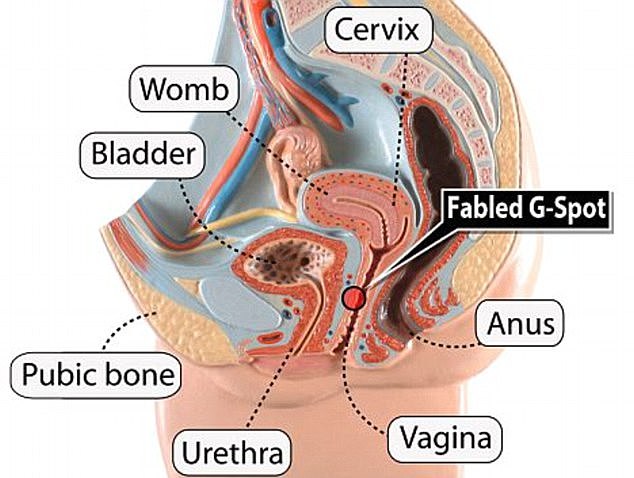Proof the G-spot IS real? Surgeons find delicate op on elusive zone meant to give women mind-blowing orgasms can kill their sex lives
It’s an elusive zone that supposedly gives women mind-blowing orgasms when stimulated.
But for years, scientists – and men too, to the frustration of their partners – have been unable to prove that the G-spot exists.
Now, however, researchers in Turkey claim they have proof that the erogenous zone is real, after discovering that women experienced fewer and less intense orgasms after surgery on the sensitive area.
Medics monitored dozens of women for six months after they underwent surgery to treat prolapse, which involves tightening the muscles in the front wall of the vagina.
This area is believed to contain the G-spot, which is said to be located several inches within the upper walls of the vagina.
While women’s arousal levels remained the same after surgery, the results showed that their sexual pleasure decreased.
Authors of the article said the G-spot was “likely damaged during this surgery.”
Researchers in Turkey claim they have proof the G-spot exists after women reported a drop in orgasm frequency and intensity after surgery on the area

The G-spot is said to be a few inches into the upper walls of the vagina
The procedure aims to repair a prolapse of the anterior vaginal wall, which occurs when weakened muscles cause the bladder to sink into the anterior wall of the vagina.
Researchers from Koru Ankara Hospital said it is one of the “most common” gynecological problems. It is usually caused by childbirth, menopause or obesity, which weakens the pelvic floor muscles.
Symptoms may include a feeling of heaviness around the lower abdomen and genitals, difficulty urinating, and discomfort or numbness during sex.
Patients with severe prolapse that is affecting their daily life may be referred for an anterior colporrhaphy, which involves tightening the muscles in the front wall of the vagina that hold the bladder in place.
The researchers noted that the surgery should improve or restore patients’ quality of life.
However, it is unclear whether the procedure affects sexual satisfaction, they said.
They noted that it can damage the erotogenic zone on the front wall of the vagina known as the G-spot, which swells during sex and is thought to play an “important role” in orgasm.
Researchers looked at 89 patients, ages 24 to 62, who had the procedure between May and December 2021.
Participants were asked about their sexual experiences before surgery and six months afterward.
Results, published in the European Journal of Obstetrics and Gynecology and Reproductive Biologyshow that patients’ sexual desire and arousal did not change.
However, there was a ‘notable’ drop in the frequency of orgasm after surgery, while intensity also decreased and pain increased.
The researchers suggested that this was due to the G-spot being damaged during surgery – even though its existence is still technically unproven.
They noted that it is generally agreed that the anterior wall of the vagina is “one of the most important structures for female sexual orgasm.”
As a result, physicians should consider alternative treatments for vaginal anterior wall prolapse where appropriate, such as laser therapy to maintain sexual pleasure, the team said.
But they only followed patients for six months while they were still recovering from surgery, which could affect the results.
Longer-term studies would be needed to confirm their findings, they admitted.
The G-spot is named after the German gynecologist Ernst Gräfenberg, who described the orgasm-producing area in the 1950s.
Dr. Gräfenberg himself did not coin the term. But he was the first to scientifically describe an “erotic zone” located “on the anterior wall of the vagina along the course of the urethra.”
The ‘G-spot’ was named after him by Dr. Frank Addiego and colleagues, who wrote about female ejaculation in the 1980s.
However, the science behind the G-spot is controversial, with several studies claiming that it doesn’t exist because even researchers can’t find it.
Some argue that there is no single spot and that five separate ‘erotogenic’ tissues carry out the pleasure sensations attributed to the G-spot.
Portuguese scientists even described the G-spot as akin to the lost city of Atlantis, after failing to determine its location, size or nature.
Another hypothesis is that the G-spot is simply a deep inner part of the clitoris that is stimulated during sex.
Some experts have claimed that studies claiming the G-spot doesn’t exist discount the experiences of women who claim to have one.
Others argue that a focus on the G-spot, in terms of female sexual pleasure, can leave those who struggle to orgasm due to the stimulation feeling ‘inadequate or abnormal’.
